

Revolutionary War: Document shows orders for officers recruiting new soldiers for the Continental Army. The Vault is Slate's new history blog.
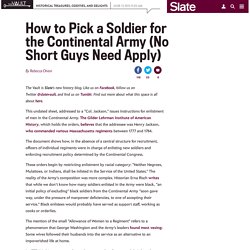
Like us on Facebook, follow us on Twitter @slatevault, and find us on Tumblr. Find out more about what this space is all about here. This undated sheet, addressed to a “Col. Jackson,” issues instructions for enlistment of men in the Continental Army. Band of Giants, The Amateur Soldiers Who Won America's Independence. “Use every precaution or I perish”: Breaking Dr. Benjamin Church’s Code. Ever since we’ve been recording information, we’ve been trying to find ways to keep it out of the wrong hands.
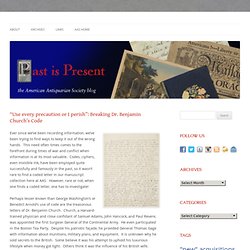
This need often times comes to the forefront during times of war and conflict when information is at its most valuable. Codes, ciphers, even invisible ink, have been employed quite successfully and famously in the past, so it wasn’t rare to find a coded letter in our manuscript collection here at AAS. However, rare or not, when one finds a coded letter, one has to investigate! Perhaps lesser known than George Washington’s or Benedict Arnold’s use of code are the treasonous letters of Dr. Benjamin Church. One of Church’s coded letters, written from Philadelphia in 1777, was deciphered by Samuel West, a former classmate of Church’s from Harvard.
Revolutionary War: Document shows orders for officers recruiting new soldiers for the Continental Army. Surrender of Cornwallis: Front page of a newspaper celebrating the colonists' victory. Two Revolutionary War Maps of Boston Harbor (1776) Teaching the Declaration of Independence as a Break Up Letter - Podcast and Video. Images of the American Revolution.
Background Many factors contributed to the eventual success of the American colonies as they revolted against British rule.
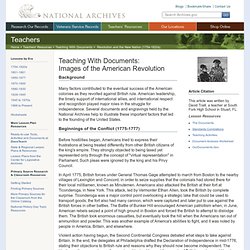
American leadership, the timely support of international allies, and international respect and recognition played major roles in the struggle for independence. Several documents and engravings held by the National Archives help to illustrate these important factors that led to the founding of the United States. Beginnings of the Conflict (1775-1777) Before hostilities began, Americans tried to express their frustrations at being treated differently from other British citizens of the king's empire. In April 1775, British forces under General Thomas Gage attempted to march from Boston to the nearby villages of Lexington and Concord, in order to seize supplies that the colonials had stored there for their local militiamen, known as Minutemen.
Violent action having begun, the Second Continental Congress debated what steps to take against Britain. 10 Resources for Teaching About the American Revolution. Pictures of the Revolutionary War. National Archives and Records Administration Washington, DC 20408 Cover Photograph: Bunker Hill.
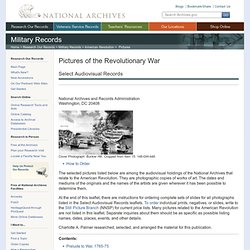
Cropped from item 15. 148-GW-448. How to Order. Teaching the Declaration of Independence as a Break Up Letter - Podcast and Video. Declaration of Independence - Text Transcript. The Declaration of Independence: A Transcription IN CONGRESS, July 4, 1776.
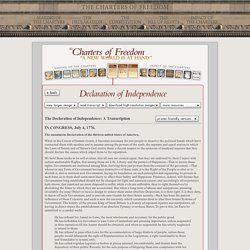
The unanimous Declaration of the thirteen united States of America, When in the Course of human events, it becomes necessary for one people to dissolve the political bands which have connected them with another, and to assume among the powers of the earth, the separate and equal station to which the Laws of Nature and of Nature's God entitle them, a decent respect to the opinions of mankind requires that they should declare the causes which impel them to the separation. We hold these truths to be self-evident, that all men are created equal, that they are endowed by their Creator with certain unalienable Rights, that among these are Life, Liberty and the pursuit of Happiness. He has refused his Assent to Laws, the most wholesome and necessary for the public good. Nor have We been wanting in attentions to our Brittish brethren.
Images of the American Revolution. Standards Correlations This lesson correlates to the National History Standards.
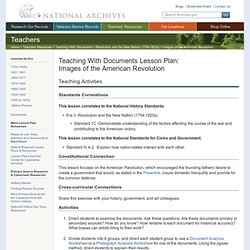
Era 3 -Revolution and the New Nation (1754-1820s) Standard 1C -Demonstrate understanding of the factors affecting the course of the war and contributing to the American victory. This lesson correlates to the National Standards for Civics and Government. Standard IV.A.2. -Explain how nation-states interact with each other. Constitutional Connection This lesson focuses on the American Revolution, which encouraged the founding fathers' desire to create a government that would, as stated in the Preamble, insure domestic tranquility and provide for the common defense. Cross-curricular Connections Share this exercise with your history, government, and art colleagues. Activities Direct students to examine the documents. The documents included in this project are available online through the following Online Catalog (OPA) National Archives Identifiers: Return to Lesson Main Page.
Alcohol to Zealotry: The Revolution A to Z (Part 1) - Journal of the American Revolution. Revolutionary War chart: Historical chart of battles and milestones of the War of Independence. The Vault is Slate's history blog.
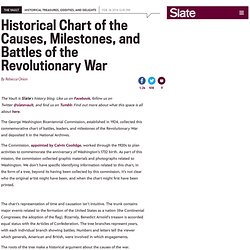
Like us on Facebook, follow us on Twitter @slatevault, and find us on Tumblr. Find out more about what this space is all about here. The George Washington Bicentennial Commission, established in 1924, collected this commemorative chart of battles, leaders, and milestones of the Revolutionary War and deposited it in the National Archives. The Commission, appointed by Calvin Coolidge, worked through the 1920s to plan activities to commemorate the anniversary of Washington’s 1732 birth. As part of this mission, the commission collected graphic materials and photographs related to Washington.